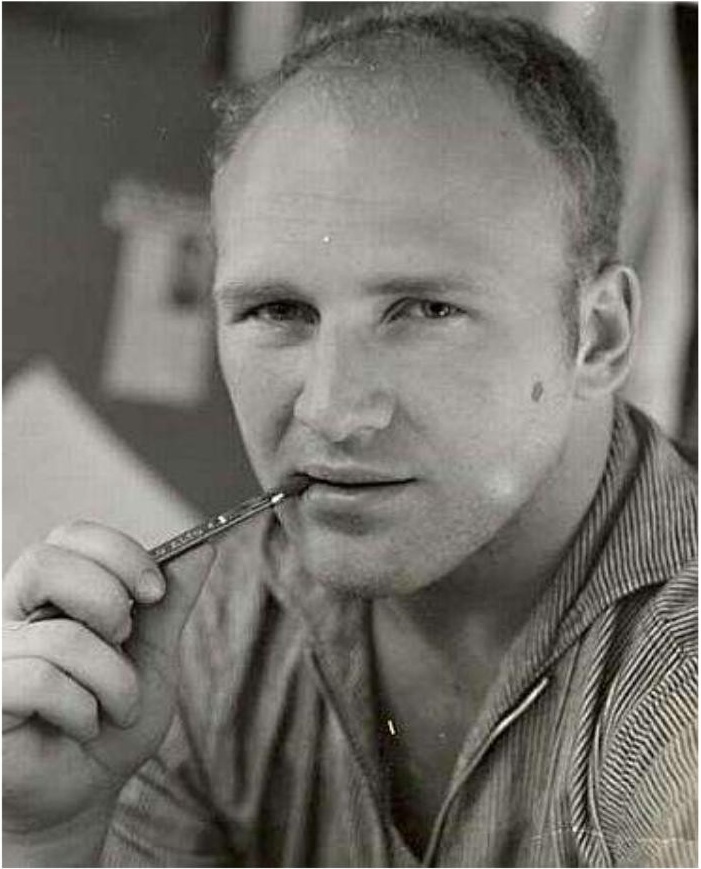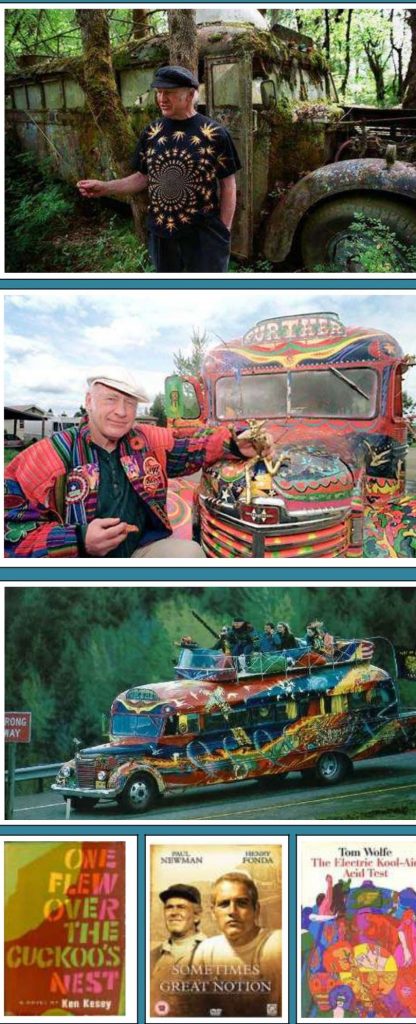By Terry Sovil from the April 2011 Edition
With the Merry Pranksters
“I am in the ocean, doing nothing, just bobbing.”
Kenneth Elton Kesey, September 17, 1935 to November 10, 2001, was a novelist, a psychedelic notable of the counter-culture and leader of the Merry Pranksters. He considered himself a link between the Beat
Generation of the 1950’s and the hippies of the 1960s. “I was too young to be a beatnik and too old to be a hippie” he said. “The Electric Kool-Aid Acid Test”, written by Tom Wolfe, tells part of his story.
Kesey, working as a night aid at the Menlo Park Veterans Hospital in 1959, volunteered to participate in a CIA-financed study, Project MKULTRA, on the effects of psychoactive drugs. Kesey wrote articles on his experiences during the project as well as experiences of private experimentation afterwards. The combination of the project and his work at the hospital inspired his book “One Flew Over the Cuckoo’s Nest” in 1962. The book was adapted into the movie which won the “Big Five” Academy Awards: Best Picture, Best Actor (Jack Nicholson), Best Actress, Best Director, and Best Adapted Screenplay.
Kesey talked with patients on his night shift at the hospital, often under the influence of the drugs he had volunteered to test. He did not believe the patients were insane but merely did not fit what was regarded as “normal behavior”.
Kesey published a second novel, “Sometimes a Great Notion” in 1964 and had to visit New York. He gathered friends and they called themselves the Merry Pranksters. They made the trip from California to New York in an old school bus named “Further”, a 1939 International Harvester bus. The book was made into a film in 1971 with Paul Newman starring and directing. It was nominated for two Academy Awards and in 1972 was the first film shown by the new HBO television network.
The success of the books allowed him to relocate south of San Francisco where he entertained friends and guests with parties called “Acid Tests”. These parties involved music by The Warlocks later called the Grateful Dead, black lights, fluorescent paint, strobes and LSD.
The “tests” ran from 1965-1966. Kesey was introduced to Allen Ginsberg, who wrote poems about them, Tom Wolfe included accounts in his book and Hunter S. Thompson wrote about them. A friend introduced him to Timothy Leary.

In 1965 Kesey was twice arrested for marijuana possession. Facing jail time he faked a suicide with his friends leaving his truck on a cliff-side near Eureka, California with an elaborate suicide note written by the pranksters. The headlines announced his suicide: “LSD GURU SUICIDE!” Kesey fled to Mexico. He ended up in Manzanillo in 1966, a man hunted by the F.B.I. and Mexican Federales.
written by the pranksters. The headlines announced his suicide: “LSD GURU SUICIDE!” Kesey fled to Mexico. He ended up in Manzanillo in 1966, a man hunted by the F.B.I. and Mexican Federales.
In 1966 Manzanillo was more of a port town jungle outpost at the end of a two lane road to Guadalajara. This is where Kesey parked his Magic Bus “Further”, and turned on the music from his loudspeaker system. He was joined by his wife, Faye, their children and pranksters. Kesey and family rented a house on the beach down near The LaPosada hotel in Las Brisas. The pranksters hang hammocks in an abandoned pet food factory they called La Casa Purina.
“It isn’t by getting out of the world that we become enlightened, but by getting into the world … by getting so tuned in that we can ride the waves of our existence and never
get tossed because we become the waves.”
Bart Varelmann describes them in his book, “The Innkeeper”, his auto-biography with a great history of Manzanillo. He doesn’t mention Kesey in detail but he does describe the pranksters as men of all ages, little kids, grandmothers, babies and girls. They parked the Magic Bus north of the La Posada by the big rock that would become Roca Del Mar.
Varelmann noted that at that time soft drugs were easy to obtain in the market. He describes their music as dreamy, pre-rock by Miles Davis and Stan Kenton. They enjoy the weather and the heat and humidity they called “Manzanillo mucus”. They swam, fished, did laundry and partied. It lasted only until the fall, a few days before their visas expired. Kesey returned to the USA, did his five months in jail and got back to being an author and icon.
Robert Stone, a prankster, wrote about Manzanillo in 2007: “In the moments after dawn, before the sun had reached the peaks of the sierra, the slopes and valleys of the rain forest would explode in green light, erupting inside a silence that seemed barely to contain it. When the sun’s rays spilled over the ridge, they discovered dozens of silvery waterspouts and dissolved them into smoky rainbows.” They called the light “Prime Green”.
Kesey started to suffer a series of health problems starting in 1997. He had a stroke that year and was diagnosed with diabetes. October 25, 2001, Kesey had a tumor removed from his liver. There were complications from the surgery and he died on November 10, 2001 at age 66.
Kesey’s writings included:
1. “One Flew Over the Cuckoo’s Nest” in 1962
2. “Genesis West: Volume Five” a 1963 magazine article
3. “Sometimes a Great Notion” in 1954
4. “Kesey’s Garage Sale” in 1973, a collection of essays including the play “Over the Border” based on his time spent in Mexico hiding from drug charges in the USA
5. “Demon Box in 1986, short stories and essays
6. “Caverns” a 1989 novel,
7. “The Further Inquiry” in 1990, a play
8. “Sailor Song” in 1992, a novel
9. “Last Go Round” in 1994, a novel co-written
10. “Twister: A Ritual Reality” in 1994, a musical play
11. “Kesey’s Jail Journal in 2003, a collection of essays
Download the full edition or view it online
—
Terry is a founding partner and scuba instructor for Aquatic Sports and Adventures (Deportes y Aventuras Acuáticas) in Manzanillo. A PADI (Professional Association of Dive Instructors) Master Instructor in his 36th year as a PADI Professional. He also holds 15 Specialty Instructor Course ratings. Terry held a US Coast Guard 50-Ton Masters (Captain’s) License. In his past corporate life, he worked in computers from 1973 to 2005 from a computer operator to a project manager for companies including GE Capital Fleet Services and Target. From 2005 to 2008, he developed and oversaw delivery of training to Target’s Loss Prevention (Asset Protection) employees on the West Coast, USA. He led a network of 80+ instructors, evaluated training, performed needs assessments and gathered feedback on the delivery of training, conducted training in Crisis Leadership and Non-Violent Crisis Intervention to Target executives. Independently, he has taught hundreds of hours of skills-based training in American Red Cross CPR, First Aid, SCUBA and sailing and managed a staff of Project Managers at LogicBay in the production of multi-media training and web sites in a fast-paced environment of artists, instructional designers, writers and developers, creating a variety of interactive training and support products for Fortune 1000 companies.




You must be logged in to post a comment.